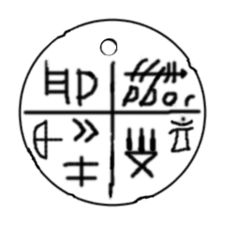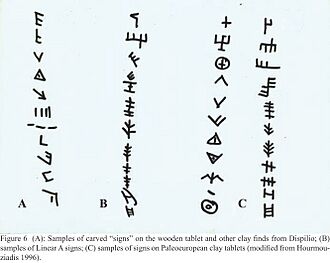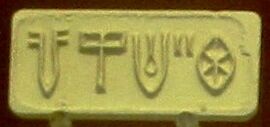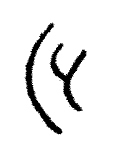Proto-writing facts for kids
Art of a painted animal at Lascaux
|
Proto-writing means using visible marks to share simple information. Think of it as a very early step towards real writing. These systems came from even older ways of using symbols. They started around 7,000 BC in places like China and southeastern Europe.
Proto-writing used pictures or simple symbols to show a few ideas. It was different from true writing systems, which can record everything someone says.
Contents
Ancient Symbols: The Paleolithic Era
In 2022, a study looked at lines, dots, and "Y" shapes on very old cave paintings. These paintings were made by people in the Upper Palaeolithic period, about 20,000 years ago.
Scientists think these symbols were used to track when animals mated. They might have been an early type of lunar calendar, which follows the moon's cycles. These markings are much older than any other known writing systems.
Early Marks: The Neolithic Era
Ancient Symbols in China
In 2003, archaeologists found turtle shells with carved symbols in China. These were found in ancient graves at a place called Jiahu. Scientists used radiocarbon dating to find out they were from about 7,000 BC.
Some experts believe these symbols look like the very first Chinese writing. This writing was found on oracle bone inscriptions from about 1,200 BC. However, other archaeologists disagree. They say simple shapes like these might not be linked to real writing.
Ancient Symbols in Southeastern Europe
A wooden tablet with carvings was found in Greece in 1993. It's called the Dispilio Tablet. This tablet is about 7,200 years old! It was found in an old village built on an island in a lake.

The Vinča symbols are another example from southeastern Europe. They started as simple marks around 7,000 BC. Over time, these symbols became more complex. They eventually led to the Tărtăria tablets, which are from about 5,300 BC.
From Symbols to Writing: Chalcolithic and Early Bronze Age
Between 3,600 and 3,200 BC, proto-writing in the Fertile Crescent slowly turned into cuneiform. This was one of the first complete writing systems.
Proto-writing in Mesopotamia
The Kish tablet is an example from about 3,500 BC. It shows an early stage of proto-cuneiform. At first, people used a round stick to press marks into soft clay. This helped them keep track of numbers on clay tablets.
Later, they added pictures using a sharp stick to show what they were counting. This system slowly became a true writing system around 3,100 to 2,900 BC.
Proto-writing in Egypt
Something similar happened with Egyptian hieroglyphs. Some experts think Egyptian hieroglyphs appeared a little after Sumerian writing. They might have been influenced by it. However, there isn't strong proof of this. Other experts believe that writing in Egypt developed on its own.
Bronze Age: The Rise of Full Writing Systems
During the Bronze Age, places in the Ancient Near East had full writing systems. But other areas, like Europe, India, and China, were still using proto-writing.
The Chinese script developed from proto-writing during the Chinese Bronze Age. This happened around 1400 to 1100 BC. In Europe and India, the early symbol systems died out. They were later replaced by writing systems that came from the Phoenician alphabet.
Indian Bronze Age Symbols
The Indus script is a system of symbols from the Indus Valley Civilisation. It appeared around the end of the 4th millennium BC.
European Bronze Age Symbols
Most of Europe did not have writing systems during the Bronze Age. The first writing systems in Europe appeared much later, during the Iron Age. These came from the Phoenician alphabet.
However, some symbols found on European Bronze Age objects might be a local form of proto-writing. For example, some bronze sickles from the second half of the 2nd millennium BC have markings. Some people think these marks might be prehistoric numerals (numbers) linked to a lunar calendar.
Later Proto-writing Systems
Even after the Bronze Age, some cultures used proto-writing before getting a full writing system. For example, some medieval writers mentioned "Slavic runes" from the 7th or 8th century. Another example is the picture-based system invented by Uyaquk around 1900, before the Yugtun script was developed.
African Iron Age Symbols
Nsibidi is a system of symbols from what is now southeastern Nigeria. Most researchers believe these symbols were first used between the 5th and 15th centuries. There are thousands of Nsibidi symbols. They were used on many things, like bowls, tattoos, and wall designs. Nsibidi was used for the Ekoid languages and Igboid languages. The Aro people were known to write Nsibidi messages on the bodies of their messengers.
See also
- Asemic writing
- Cylcon
- Dispilio Tablet
- History of ancient numeral systems
- History of communication
- History of writing
- Message stick
- Megalithic graffiti symbols
- Petroglyph
- Prehistoric counting
- Quipu
- Visual language






